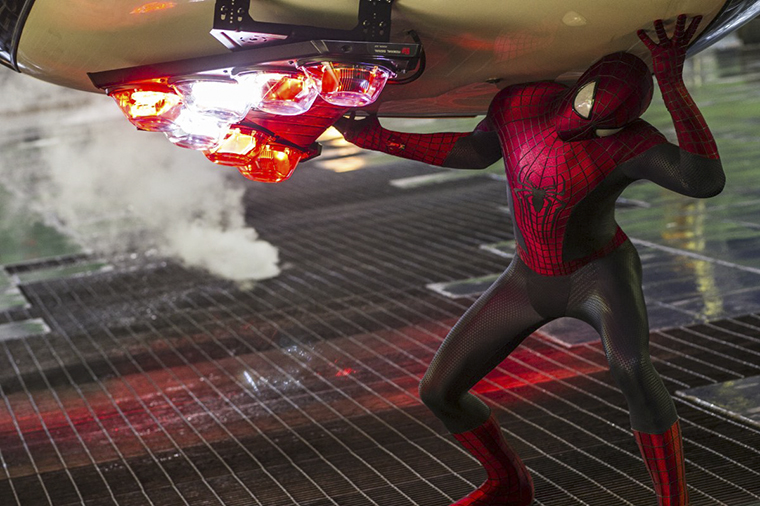‘Spider-Man 2’ swings short of legacy
‘Amazing Spiderman 2’ swings too low.
May 12, 2014
Marvel’s monopoly on spinning superhero stories continues to grow with every new release, and these films have to go big or go home. Director Marc Webb’s “The Amazing Spider-Man 2” is the first in this year’s summer blockbuster lineup and grossed $375 million as of press time. Unfortunately, the new addition to the Spider-Man franchise has too many villains and subplots, and the messy narrative makes the film feel rushed.
“The Amazing Spider-Man 2” picks up a few months after the events of the first film. Max Dillon (Jamie Foxx), a scientist for shady technology corporation Oscorp, has an accident in a laboratory, which turns him into Electro, a blue glowing superhuman with the ability to manipulate electricity. The frightened Dillon searches for Spider-Man (Andrew Garfield, “The Social Network”), believing Peter Parker’s alter ego can help him. They meet in Times Square, but terrified police officers attack Electro after he accidentally causes a blackout. Spider-Man subdues him, and Electro is taken to a secret facility. Concurrently, Harry Osborn (Dane DeHaan, “Chronicle”), Parker’s childhood friend and heir to Oscorp, returns home to run the company after his father dies of a mysterious genetic illness that slowly kills its host. Osborn, who also suffers from the disease, reaches out to Spider-Man for help, believing the spider venom in his blood can heal him. Spider-Man declines to help, afraid the transfusion will kill Osborn. Enraged, Osborn decides to take revenge on Spider-Man, enlisting the help of Electro, who blames Spider-Man for his imprisonment. The two break into Oscorp’s secret projects facility, where Osborn finds a mechanical suit of armor and turns himself into the Green Goblin.
The performances are a mixed bag. Garfield shines as Peter Parker/Spider-Man, expertly embodying the role and bringing the character right off the comic panels, shifting between comedic and dramatic moments with ease. The biggest addition to the roster is Osborn, played by DeHaan. The decision to include the villain is controversial, considering his important appearances in all three of Sam Riami’s “Spider-Man” films. The role, originally played by James Franco, is far different in the new film. Franco’s Osborn had a strong character arc, beginning as Peter’s best friend and becoming his eventual enemy. However, the new iteration of Osborn is an angst-ridden and unlikable sleaze with daddy issues, although this is mostly because of DeHaan’s eye-rolling-worthy overacting, making the character all the more unintentionally unlikable.
The film suffers from too many villains. Electro and Green Goblin could each hold his own as a principal adversary, but instead their plotlines are condensed. Electro is well established for his first time on the big screen, but he spends most of the film in captivity. Electro is more of a physical threat to Spider-Man, whereas Green Goblin is a psychological threat because of his relationship with Parker. The film jumps quickly between the two villains, but they don’t come together until the end.
The second half of the film lacks action and is mostly focused on connecting both stories surrounding the villains and building on its multiple subplots rather than developing a cohesive plotline to engage audiences.
It’s clear that director Marc Webb wanted to cover a huge amount of ground in this film, but the endeavor creates a messy narrative. In addition to Spider-Man’s problems, Peter attempts to solve a mystery surrounding his late father, sustain a strained relationship with Gwen Stacy (Emma Stone, “The Help”) and deal with Osborn’s problems. The smaller plot-threads keep the story moving at a brisk pace, but not all of it is interesting. By the end of the film, Parker and Stacy’s relationship runs in circles, rehashing the same problems without introducing anything new. The mystery behind Parker’s father is compelling, but it’s far too short and the impact it has on the broader narrative is minimal. Peter’s personal journey is just composed of these subplots, whereas the main villains have one-directional character arcs that actually help the plot move in the direction that it needs to. Parker doesn’t interact with the villains enough throughout the second act, which greatly slows down the story.
Sequels aim high, but “The Amazing Spider-Man 2” swings too low. Although it is visually impressive, the messy narrative tries to cover too much ground, and the film collapses under its own weight.








